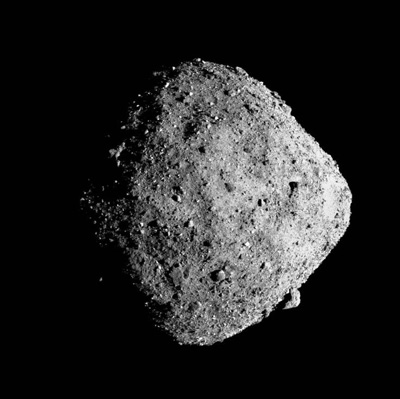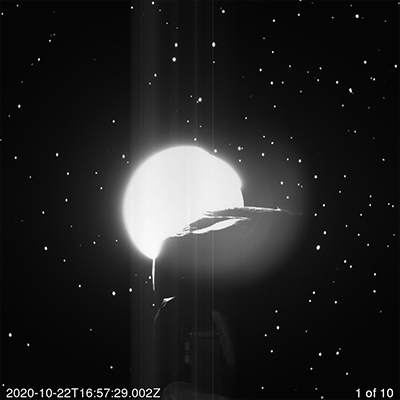On 20 October 2020, the OSIRIS-REx (Origins, Spectral Interpretation, Resource Identification, Security–Regolith Explorer) mission met its watershed moment. Four years after its launch and nearly 2 decades after the mission was conceived, the day had finally come when the spacecraft would attempt to pluck a sample from a tiny patch of smooth terrain on the otherwise rocky, hazard-packed surface of asteroid Bennu.
Despite some surprises, that momentous operation proved successful, setting the stage for the mission’s next act. In May 2021, 7 months after its close encounter with Bennu, OSIRIS-REx departed on its journey home, where it’s expected to drop off its cargo in September 2023. Now scientists are eagerly preparing for their opportunity to look at the asteroid under the microscope and put hypotheses about its origins and evolution to the test.
A Delicate “Touch-and-Go” Maneuver
The team watched in astonishment as images came back of a surface strewn with boulders, many of them larger than commuter buses.
Finding that tiny patch of Bennu that was suitable for sampling was an unexpected struggle. Prelaunch astronomical observations had led mission planners to expect a sandy landscape, perfect for sucking up some asteroid regolith (loose, rocky surface material). But when the spacecraft arrived at Bennu in December 2018, the team watched in astonishment as images came back of a surface strewn with boulders, many of them larger than commuter buses, that posed serious challenges to sample collection.
The following year was spent performing a complex series of flybys and orbital surveys—record-breaking for their proximity to the asteroid—to map Bennu’s surface in high definition. These surveys resolved details as small as 5 centimeters globally and just a few millimeters in some areas. After this year of observations, the team identified a viable sampling site in the northern hemisphere—one with relatively few boulders, to minimize the risk to the spacecraft, and with abundant regolith, which improved the chances of collecting the desired sample haul of at least 60 grams. (They also chose a slightly less desirable backup site near the equator, which was not used.) At about 8 meters wide, the sample site, located in a crater, was not quite the width of three parking spaces.

During the spacecraft’s final descent in October 2020, however, the mission team couldn’t play curbside coach to help guide it into place. Pictures taken by the navigation camera would take about 18 minutes to make their way back to Earth, and any instructions would take another 18 minutes to return to Bennu. The spacecraft would have to rely on an autonomous guidance system to recognize landmarks on the surface, correct its trajectory in real time, and maneuver safely into the narrow area.
When the critical time came, anticipation was running high among the team members, but there was a pervading awareness that they had done everything possible to prepare for the moment.
A Sinking Sensation
That preparation paid off when OSIRIS-REx’s sampling device, which bears a strong resemblance to a pogo stick, unfurled from the spacecraft and touched down directly in the center of the target site, narrowly missing some rocks that might have blocked it from collecting regolith. On site at the Lockheed Martin Mission Support Area in Denver, the team members, who had worked indefatigably toward this milestone, even amid the COVID-19 pandemic, erupted in celebration.
Bennu, however, wasn’t out of surprises yet. Instead of coming to rest on solid ground, the sampling device, the only part of the spacecraft to touch the asteroid, sank about half a meter into a loosely packed, readily yielding surface layer. Bennu offered no more resistance than a person would feel when depressing the plunger on a French press coffee maker.
Assisted by a high-pressure jet of nitrogen gas to drive particles upward, regolith flooded into the annular sample collection chamber from below while other dust and rocks lofted into a debris plume overhead. When the spacecraft lifted off from Bennu seconds later, the chamber was literally packed to bursting—images taken 2 days later showed that bits of gravel had jammed the chamber’s Mylar flap open, allowing particles to escape. The hard-won sample was leaking into space, raising concerns that the unanticipated overabundance of sampled material could undo all the effort it took to collect it.

The team sprang at the earliest opportunity to prevent further leakage, instructing the spacecraft to stow the overstuffed sample collection chamber in the Earth-return capsule. An estimated 70 grams of sample were lost between the first postsampling imaging and stowage, but the spacecraft still secured between 150 and 350 grams—well above the mission’s target of 60.
Even after the unexpected leak, when the sample lands on Earth next year, it will be the most material ever returned from a world beyond our Moon.
Why Bring Back a Sample?
The payoff of sample return missions is well worth the challenge.
Had OSIRIS-REx been designed simply to survey Bennu from a distance, without going in for a sample, it would have been a much less complex and risky mission. But the payoff of sample return missions is well worth the challenge.
Bennu is a rubble pile (an official classification, not an insult) made primarily of primitive solar system materials, including water- and organic carbon–bearing compounds. These materials have survived for billions of years without experiencing the intense heat and pressure of planetary consolidation or magmatic processing (although they have undergone hydrothermal alteration and surface weathering). However, carbonaceous chondrites that have fallen to Earth as meteorites are similarly primitive, so why take a scoop from Bennu?
One limitation of meteorites is that they land unprotected on Earth, and chemical contamination from Earth’s environment complicates our interpretation of them. The collection of meteorites that reach Earth’s surface is also biased, containing only materials sturdy enough to withstand atmospheric entry, which may preclude porous boulders like those on Bennu. And although it has been possible to link some meteorites to asteroid families or other planetary bodies, we have no way of knowing the specific geologic context from which they originated; they are hand samples from unknown outcrops.
Sample return missions address all those problems by acquiring material directly from a well-characterized source and controlling its environment during atmospheric entry and Earth landing. Japan’s Hayabusa2 mission recently brought back samples from asteroid Ryugu, which are already proving to have properties distinct from those of known meteorites. Bennu and Ryugu are both carbonaceous asteroids that may share similar origins but probably have had different histories since. With the samples from Ryugu and Bennu, we are poised for a major leap forward in deciphering the evolution of our solar system.
What Happens When the Sample Lands?
The OSIRIS-REx spacecraft will drop the capsule containing the Bennu sample into the Utah Test and Training Range on 24 September 2023. The capsule, about as big around as a car tire, is outfitted with a heat shield to protect it during its fall through the atmosphere and a parachute to slow its descent. Upon landing, it will be transported to the astromaterials curation facility at NASA’s Johnson Space Center (JSC) in Houston.
JSC curators will open the canister containing the sample under strictly controlled conditions inside a clean room glove box. That moment will mark the denouement of the OSIRIS-REx space mission while simultaneously kicking off an intensive 2-year sample analysis program involving researchers and laboratories all over the world. (Meanwhile, the spacecraft itself will continue in orbit as it waits for its next target of observation, asteroid Apophis, to arrive for a close encounter with Earth in 2029.)
The idea is to use the sample gradually, preserving some for future generations of scientists who will pose questions and develop techniques not yet conceived.
Only a quarter of the sample mass, however, will be analyzed by OSIRIS-REx team members. Small portions will go to international partners in Japan and Canada, and most of the rest will be archived at JSC. Once the sample catalog is publicly released in spring 2024, researchers from the broader scientific community will be able to request small amounts to study. The idea is to use the sample gradually, preserving some for future generations of scientists who will pose questions and develop techniques not yet conceived, as was done with lunar samples retrieved during the Apollo missions.
Limited Sample, Unlimited Questions
An almost boundless range of informative analyses could be performed on pristine extraterrestrial materials, but the available sample from Bennu is finite. Some of the most illuminating techniques (e.g., atomic probe tomography, nuclear magnetic resonance spectroscopy, nanoscale secondary ion mass spectrometry) contaminate or destroy sample material (some do both). Communication among team members and strategic sequencing of analyses are crucial for maximizing the scientific return from a limited resource.
Coordinating these activities across a globally distributed group of researchers is no trivial task. One way the mission team will tackle this challenge is through a microinformation system, which is conceptually similar to a geographic information system (GIS) but on a microscopic scale. This tool spatially coregisters data from multiple sources, enabling visualization and overlay of information and images from different types of instruments. A corresponding smartphone app tracks the location of each subsample and the preparation and analytical techniques to which it has been subjected. In addition to facilitating collaboration, this system will expedite the archiving of sample data in public repositories for community use.
The OSIRIS-REx team’s analytical strategy is driven by hypotheses that explore Bennu’s fundamental nature and geologic history.
As for the science itself, the OSIRIS-REx team’s analytical strategy is driven by hypotheses that explore Bennu’s fundamental nature and geologic history. The sample will help trace the hypothesized evolution of Bennu’s constituent materials: from their origins in the nebulous cloud that preceded our solar system; through their accretion into a large precursor asteroid in the main asteroid belt between Mars and Jupiter, that asteroid’s destruction through a collision with another massive object, and the reaccumulation of resulting debris to form Bennu and other orbiting rubble piles; and, finally, to Bennu’s geologically recent migration to near-Earth space and space weathering (e.g., by irradiation and meteoroid bombardment) along the way.
To set up these lines of inquiry, the first hypothesis to be tested is whether Bennu has the characteristics predicted from the spacecraft observations. In particular, the team expects to see weak, porous stones consisting of hydrated clay minerals, carbon-bearing compounds (including prebiotic organics and hydrothermally deposited carbonate veins), the iron oxide mineral magnetite, and possibly small amounts of basaltic pyroxene that were probably delivered to Bennu’s precursor by projectiles from asteroid Vesta.
The evidence underlying these predictions gives the team confidence in our understanding of Bennu so far, but no doubt the asteroid has more surprises in store. Victor Hugo wrote in Les Misérables, “Where the telescope ends, the microscope begins. Which of the two has the grander view?” OSIRIS-REx scientists are ready to zoom in on Bennu’s mysteries when the time comes—and are hoping they get a grand view indeed.
Author Information
C. W. V. Wolner ([email protected]), Lunar and Planetary Laboratory, University of Arizona, Tucson


